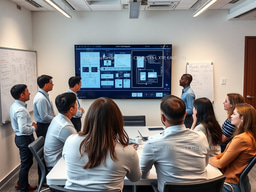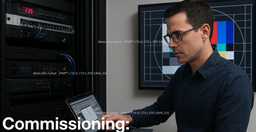Guidelines for Managing and Coordinating Audio-Visual System Design and Installation: Following AVIXA Standards for Successful Projects

Are you looking for guideline for managing/coordinating design and installation of audio-visual system/Project ; AVIXA standards ANSI/AVIXA D401.01:2023 formerly (ANSI/INFOCOMM 2M-2010 ) establish best practice for documentation and communication and managing the various phases of an AV project.
Whoever involve in AV projects , you can follow these process which help ensuring a successful outcome that meets the client need on time and budget:
-Program Phase:
-
- Conduct a needs analysis through programming meetings with stakeholders to understand requirements
- Perform interviews with end users and administrators to evaluate experiences and visions.
- Administer questionnaires and surveys to gather additional insights.
- Conduct site visits and use checklists to document existing conditions and pain points.
- Capture all findings in a non-technical Program Report defining needs, purposes, budgets.
- Distribute the report for review and obtain sign-off before advancing to design.
- Design Phase
-
- Develop architectural drawings showing device locations, sightlines, mounting details.
- Create infrastructure drawings depicting pathways, terminations, equipment rooms.
- Generate AV system drawings including functional diagrams, rack elevations, and custom details.
- Draft specifications describing equipment, standards, testing and closeout requirements.
- Coordinate design intent and resolve issues through regular meetings with related disciplines.
- Construction Phase
-
- Develop shop drawings translating design documents into fabrication and installation guidance.
- Procure equipment and materials according to drawings and specifications.
- Coordinate on-site installation through construction meetings and RFI resolution process.
- Perform testing to verify systems meet performance goals before client acceptance.
- Testing and Closeout
-
- Perform technical and operational testing to verify systems meet design intent. Technical testing ensures proper installation, while operational testing evaluates usability.
- Qualified technicians conduct thorough testing using standardized procedures outlined in documentation.
- Document test results in reports submitted for review and approval.
- Address any non-compliant issues before obtaining client sign-off.
- Provide as-built drawings accurately reflecting any installation changes.
- Compile operation manuals, warranties, closeout documentation for handover.
- Optional Services
-
- Mockups allow clients to visualize and test configurations, improving understanding and buy-in.
- Control system programming customizes the user experience for intuitive operation.
- Maintenance agreements provide ongoing support and repairs under warranty coverage.
- Seminars educate clients on technologies, standards and best practices over the system lifetime.
- First-use support eases the transition to ongoing operations after acceptance.
- Outsourcing services like help desks can reduce the long-term management burden.
- Coordination
-
- Checklists define tasks, deliverables, responsibilities and due dates for each project stage.
- Assigning roles clarifies accountability and avoids issues from unclear or missing expectations.
- Coordinating with specialists resolves challenges proactively through documentation.
- Meetings provide opportunities to align expectations, review submittals, and address issues.
- Adhering to consistent processes and templates streamlines collaboration across disciplines.
In overall, the ANSI/AVIXA D401.01:2023 standard provides a framework for coordinating complex AV system designs and installations. By outlining standardized processes from programming to closeout, it establishes clear expectations and accountability across multi-disciplinary teams. Applying the guidelines helps ensure technical and operational goals are met on schedule and budget. Addressing challenges proactively through documentation and collaboration further increases chances for success. Following industry-recognized best practices in project management and coordination ultimately aims to satisfy stakeholder needs - the ultimate objective for any AV systems integration project.
-
Xchange Advocates are recognized AV/IT industry thought leaders and influencers. We invite you to connect with them and follow their activity across the community as they offer valuable insights and expertise while advocating for and building awareness of the AV industry.
Recommended Content
LetsTalkAVbyAlexis Series: Episode 4 : Design Begins With People: Engineering AV Systems Around Real End-User Requirements

LetsTalkAVbyAlexis Series : Episode 2: Network & AV Convergence (AVoIP)





Please sign in or register for FREE
If you are a registered user on AVIXA Xchange, please sign in
Excellent summary @Alexis Bou Farhat, CTS-D, CTS-I. We run our business this exact way as described. It is a trusted recipe for guaranteed success for our clients! Thanks for the in depth share
Thanks @David Allara !